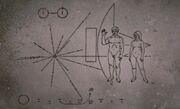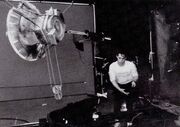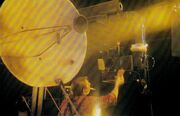m (Bot: Automated text replacement (-\*{{[Ww]ikipedia +* {{wikipedia) !!wikia-credits fix!!) |
Renegade54 (talk | contribs) m (formatting) Tag: sourceedit |
||
| (17 intermediate revisions by 9 users not shown) | |||
| Line 1: | Line 1: | ||
| + | {{sidebar starship |
||
| ⚫ | |||
| + | |image = Pioneer10.jpg |
||
| − | [[File:Pioneer_10_plaque.jpg|thumb|The ''Pioneer 10'' plaque]] |
||
| − | + | |imagecap = ''Pioneer 10'' |
|
| + | |Name = ''Pioneer 10'' |
||
| ⚫ | |||
| + | |Class = Pioneer Program |
||
| + | |owner = [[United States of America]] |
||
| + | |operator = [[NASA]] |
||
| + | |Status = Destroyed |
||
| + | |Datestatus = 2287 |
||
| + | |image2 = KlaaPioneer10.jpg |
||
| + | |imagecap2 = Klaa's Bird-of-Prey approaches ''Pioneer 10'' |
||
| + | }} |
||
| ⚫ | |||
| ⚫ | |||
''Pioneer 10'' carried a [[metal]] plaque on its [[hull]], designed to give [[alien]] [[lifeform]]s basic, [[language|non-language-specific]], information about its origin and its creators. Some time before [[2287]], the probe passed into [[Klingon]] territory, where it was destroyed by the [[Klaa's Bird-of-Prey|Bird-of-Prey]] commanded by [[Captain]] [[Klaa]]. ({{film|5}}) |
''Pioneer 10'' carried a [[metal]] plaque on its [[hull]], designed to give [[alien]] [[lifeform]]s basic, [[language|non-language-specific]], information about its origin and its creators. Some time before [[2287]], the probe passed into [[Klingon]] territory, where it was destroyed by the [[Klaa's Bird-of-Prey|Bird-of-Prey]] commanded by [[Captain]] [[Klaa]]. ({{film|5}}) |
||
| − | == Background |
+ | == Background information == |
| − | * ''Pioneer 10'' was launched from Earth on March 3, 1972. |
+ | * ''Pioneer 10'' was launched from Earth on March 3, 1972. The first Human space probe to explore the outer [[Sol system|solar system]], its primary mission was to analyze the planet Jupiter. Launched on a solar escape trajectory, it became the first man-made object to leave Sol's traditional planetary zone in 1988. As it passed through the extremes of the system, it was charged with investigating particles from the solar wind and cosmic rays. Contact with the probe continued until the final successful contact attempt on January 23, 2003. ''Pioneer''{{'}}s intended course will eventually take it to the vicinity of the Aldebaran system. |
| ⚫ | |||
| + | ===Studio model=== |
||
| − | * The probe became one of the first man-made objects to leave the Solar system's planetary zone. As it passed through the extremes of the system, it was charged with investigating particles from the solar wind and cosmic rays. ''Pioneer''{{'}}s intended course was to eventually take it to the vicinity of the Aldebaran system. |
||
| + | [[File:Pioneer 10 studio model filmed.jpg|thumb|The model filmed at Ferren & Co.]] |
||
| + | Modeled after an existing piece of [[NASA]] hardware, the [[studio model]] was neither specifically designed nor built, but rather modeled after the {{wt|Pioneer 5}} for {{film|5}}. [[Gregory Jein]], whose company, Gregory Jein, Inc. was tasked with the build of the model by [[Associates and Ferren]] (NY), commented, "''The satellite was supposed to be floating junk in space which ends up being used for target practice, so certain sections had to be rigged to break away. We worked from photos of the real ''Pioneer 5'', which was surprisingly small – our model is very nearly 1:1 scale, about six feet across. The dish turned out to be the exact size and shape of a home satellite dish, so we used a real one, and [[Mike Joyce]] machined a lot of parts for its rotational axis.''" (''[[American Cinematographer]]'', July 1989, p. 81) |
||
| + | [[File:Pioneer 10 studio model in use.jpg|thumb|Ferren's [[John Gaeta]] setting up the ''Pioneer 10'' studio model for filming]] |
||
| ⚫ | |||
| + | Though delivered to Ferren's Hoboken studios according to specifications, modifications were deemed necessary. [[Robert Lyons]] of Associates and Ferren recalled, "''When we received the ''Pioneer'' probe from Greg Jein's shop, it was strictly a nonfunctional model. The requirements of the shots demanded that it have a different axis of motion above and beyond what the model mover was able to give it. So, in Hoboken, we cut open the model and built an internal structure to house a central motor. That was the mechanism that allowed it to do its spinning motion''" Unaccustomed as the effects house was with {{w|Chroma key|blue screen photography}}, the model was coated with a Y-1 yellow dulling gel, to neutralize blue-spill. Mounted vertically, problems with blue-screen photography caused Ferren and Co. to choose for a stop-motion technique (as a continuous filmed shot caused the long antennae to blur out on film) which, though promising in pre-production, ended up, after the process of post-production compositing, in a stuttering effect as was eventually shown on screen. After being hit by [[Klaa's Bird-of-Prey]] electric discharges crackled all over the NASA probe, which were animated effects, created by Animation Supervisor [[Susan Tremblay]], composited over the model shots in post-production. The model was subsequently detonated. Originally the explosion was intended to be embellished by specially shot footage of additional explosions, for which Pyrotechnics Expert [[Steve Kirshoff]] executed 26 dynamic explosions. Model Photography Designer {{dis|Michael Sullivan|photographer}} noted, chagrined, "''We shot a lot of beautiful explosions. We rented fireproof curtains and shot high-speed. As soon as we completed the pyro, we heard that the shot was out, then in, then out again. Nobody would tell us why.''" Only the original explosion that destroyed the model was used. (''[[Cinefex]]'', issue 42, p. 56,58) |
||
| + | |||
| + | ==See also== |
||
| + | * ''[[Pioneer 5]]'' |
||
| + | * ''[[Voyager 6]]'' |
||
==External link== |
==External link== |
||
* {{wikipedia-title}} |
* {{wikipedia-title}} |
||
| + | |||
[[de:Pioneer 10]] |
[[de:Pioneer 10]] |
||
| + | [[fr:Pioneer 10]] |
||
[[Category:Earth]] |
[[Category:Earth]] |
||
[[Category:Probes]] |
[[Category:Probes]] |
||
Revision as of 16:21, 13 May 2015

The Pioneer 10 plaque
Pioneer 10 was an American Pioneer Program deep space probe that was in service with NASA in the late 20th century. This probe was used for surveying the interplanetary medium past the planet Mars and for exploration of the Jovian system.
Pioneer 10 carried a metal plaque on its hull, designed to give alien lifeforms basic, non-language-specific, information about its origin and its creators. Some time before 2287, the probe passed into Klingon territory, where it was destroyed by the Bird-of-Prey commanded by Captain Klaa. (Star Trek V: The Final Frontier)
Background information
- Pioneer 10 was launched from Earth on March 3, 1972. The first Human space probe to explore the outer solar system, its primary mission was to analyze the planet Jupiter. Launched on a solar escape trajectory, it became the first man-made object to leave Sol's traditional planetary zone in 1988. As it passed through the extremes of the system, it was charged with investigating particles from the solar wind and cosmic rays. Contact with the probe continued until the final successful contact attempt on January 23, 2003. Pioneer's intended course will eventually take it to the vicinity of the Aldebaran system.
- Though depicted as being destroyed in Klingon territory in the late 23rd century, in actuality the spacecraft's speed is so slow it will not reach Aldebaran for two million years. On its current trajectory, by 2287, Pioneer 10 should be roughly 820 AU from Earth (about 0.012 light years).
Studio model

The model filmed at Ferren & Co.
Modeled after an existing piece of NASA hardware, the studio model was neither specifically designed nor built, but rather modeled after the Pioneer 5 for Star Trek V: The Final Frontier. Gregory Jein, whose company, Gregory Jein, Inc. was tasked with the build of the model by Associates and Ferren (NY), commented, "The satellite was supposed to be floating junk in space which ends up being used for target practice, so certain sections had to be rigged to break away. We worked from photos of the real Pioneer 5, which was surprisingly small – our model is very nearly 1:1 scale, about six feet across. The dish turned out to be the exact size and shape of a home satellite dish, so we used a real one, and Mike Joyce machined a lot of parts for its rotational axis." (American Cinematographer, July 1989, p. 81)

Ferren's John Gaeta setting up the Pioneer 10 studio model for filming
Though delivered to Ferren's Hoboken studios according to specifications, modifications were deemed necessary. Robert Lyons of Associates and Ferren recalled, "When we received the Pioneer probe from Greg Jein's shop, it was strictly a nonfunctional model. The requirements of the shots demanded that it have a different axis of motion above and beyond what the model mover was able to give it. So, in Hoboken, we cut open the model and built an internal structure to house a central motor. That was the mechanism that allowed it to do its spinning motion" Unaccustomed as the effects house was with blue screen photography, the model was coated with a Y-1 yellow dulling gel, to neutralize blue-spill. Mounted vertically, problems with blue-screen photography caused Ferren and Co. to choose for a stop-motion technique (as a continuous filmed shot caused the long antennae to blur out on film) which, though promising in pre-production, ended up, after the process of post-production compositing, in a stuttering effect as was eventually shown on screen. After being hit by Klaa's Bird-of-Prey electric discharges crackled all over the NASA probe, which were animated effects, created by Animation Supervisor Susan Tremblay, composited over the model shots in post-production. The model was subsequently detonated. Originally the explosion was intended to be embellished by specially shot footage of additional explosions, for which Pyrotechnics Expert Steve Kirshoff executed 26 dynamic explosions. Model Photography Designer Michael Sullivan noted, chagrined, "We shot a lot of beautiful explosions. We rented fireproof curtains and shot high-speed. As soon as we completed the pyro, we heard that the shot was out, then in, then out again. Nobody would tell us why." Only the original explosion that destroyed the model was used. (Cinefex, issue 42, p. 56,58)
